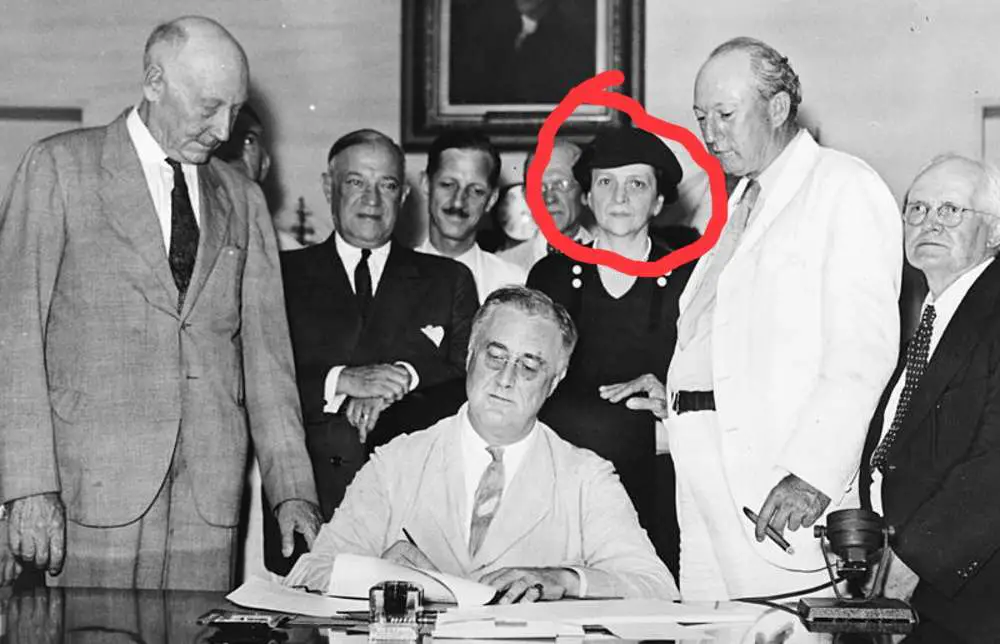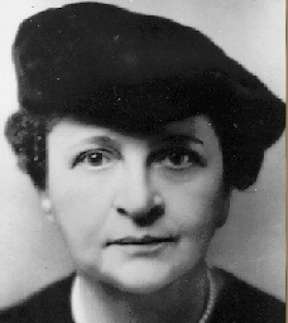Frances Perkins was having tea with her friend, Mrs. Gordon Norris, in New York City, on the afternoon of March 25, 1911, when they heard fire engines screaming by. As the sirens kept coming, Frances Perkins followed them, and what she saw changed her life.
Smoke and flames engulfed a 10-story factory. Young men and women were jumping from the windows on the top floors as the fire pressed in on them. Onlookers screamed, ‘Help is coming,’ but they were beyond help.
In the end, 146 people – 123 women and 23 men – died in one of the worst industrial disasters in history, the Triangle Shirtwaist Fire.
Frances Perkins would never forget.
Frances Perkins
She was born on April 10, 1880 in Boston, Mass., as Fannie Coralie Perkins. Her parents, natives of Maine, owned a stationers’ store. Fannie changed her name to Frances after she graduated from college.
Fannie Perkins grew up in Worcester, Mass., and graduated from Mount Holyoke College committed to social change. She taught for a while, volunteered at settlement houses and at 30 received an M.A. in political science from Columbia University.
On the day of the Triangle Shirtwaist Fire, Frances Perkins headed the New York Consumers League. She lobbied for better hours and conditions for workers. Then came the afternoon when she witnessed the horror of dozens of young men and women flinging themselves to their deaths in front of her. Of that day she said,
I shall never forget that frozen horror which came over us as we stood with our hands on our throats watching that horrible sight, knowing there was no help.
She knew about the dangers of New York’s factories because she was taking a crash course in fire safety. After she witnessed the Triangle Shirtwaist disaster, she left her job at the Consumers League. She then got a job as executive secretary for the Committee on Safety of the City of New York.
When Franklin Roosevelt was elected governor in 1929, he appointed her as New York’s first Commissioner of Labor. In that post, she fought for minimum wage and unemployment insurance laws. She also fought against child labor and dangerous workplaces.
As a close ally of Governor Roosevelt, Frances Perkins reduced the work week for women and expanded factory investigations.
Brahmin Reformer
Historian Arthur Schlesinger, Jr., described her:
Brisk and articulate, with vivid dark eyes, a broad forehead and a pointed chin, usually wearing a felt tricorn hart, she remained a Brahmin reformer, proud of her New England background . . . and intent on beating sense into the heads of those foolish people who resisted progress. She had pungency of character, a dry wit, an inner gaiety, an instinct for practicality, a profound vein of religious feeling, and a compulsion to instruct . . .
Roosevelt was elected president of the United States in November 1932. He then appointed Frances Perkins Secretary of Labor, the first woman ever to serve in a United States cabinet position on Feb. 28, 1933. When he asked her to take the job, she told him she had a long list of programs she’d fight for, including a minimum wage and Social Security. “Nothing like this has ever been done in the United States before,” she said. “You know that, don’t you?”
She then served as Secretary of Labor for 12 years, longer than anyone. In that job she played a key role in writing New Deal legislation and helping to create Social Security. She also helped oversee the Civilian Conservation Corps.
Social Security
Perkins persuaded Franklin Roosevelt to ride the wave of Townsend clubs to support a federal retirement program for workers. California physician Francis Townsend started the clubs after he saw three elderly women rooting through a garbage can for food. During the Great Depression, more than half of older Americans lived in poverty.
Thousands of Townsend clubs pressured Congress to pass an old age pension plan. Sensing the opportunity, Roosevelt agreed to Perkins’ demand. He assigned her to run the committee that would craft the legislation.
As soon as the Social Security Act passed, conservatives in Congress began to attack it as unconstitutional. Frances Perkins had made sure it would withstand judicial scrutiny. Months before Roosevelt signed the Social Security Act on Aug. 14, 1935, she had consulted with Supreme Court Justice Harlan Stone, a native of Chesterfield, N.H. He assured her the high court would support the government’s taxing power. It did.
Of her time in Washington, she said,
I came to Washington to work for God, FDR, and the millions of forgotten, plain common workingmen.
With thanks to The Woman Behind the New Deal: The Life and Legacy of Frances Perkins–Social Security, Unemployment Insurance, and the Minimum Wage by Kirstin Downey. You can learn more about Frances Perkins at the Frances Perkins Center in Damariscotta, Maine, where she spent her summers. This story was updated in 2022.



15 comments
Amazing story. Thank you for posting this!
Amazing story. Thank you for posting this!
Oooh, how sad at the factory.
A great women!
That’s my maiden name Perkins
She must not have been a Republican.
read the book The Woman Behind the New Deal by Kirstin Downey
I believe NY governor Al Smith was also in the city & he pushed for a Factory Investigative Commission. Perkins became one of the investigators. Also, the Republican Party of the time was dominated by Progressives who championed labor and environmental reform. Of course, Al Smith & FDR were Democrats.
Thank you Margaret for spreading correct knowledge.
I remember studying about this in my American History class when I went back to finish my degree. Horrible tragedy.
[…] of the Pemberton Mill was the worst industrial accident in Massachusetts history, rivaling the Triangle Shirtwaist fire 50 years later. Between 90 and 145 people were killed, and another 166 […]
[…] it was another New Englander who made sure Ida May Fuller got her check: Frances Perkins, President Franklin Roosevelt’s secretary of […]
[…] 1933 to 1946, he served as U.S. commissioner of Labor Statistics under Labor Secretary Frances Perkins. In that position, he reorganized how the bureau gathered information on employment, […]
[…] years later that she carved still another one: a memorial to the six unknown victims of the 1911 Triangle Shirtwaist Fire. The fire engulfed a dangerous garment factory in New York City, killing 146 immigrant workers who […]
[…] the Eleanor. Some people excused themselves by saying they had to visit Miss Perkins, meaning Frances Perkins, FDR’s secretary of […]
Comments are closed.